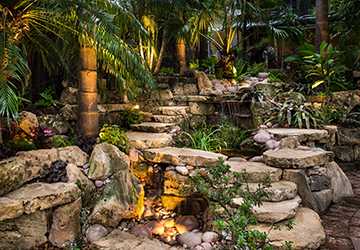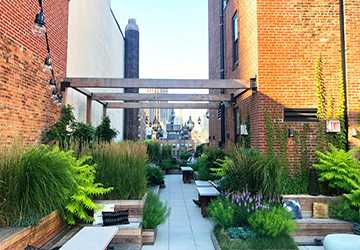In today's world, where sustainability is more than just a buzzword, designing an eco-friendly space extends beyond one's interiors. Your garden, an extension of your home, offers a unique opportunity to embrace environmentally conscious choices. Here's a comprehensive guide on integrating sustainable gardening practices, eco-friendly landscaping strategies, and green garden designs to curate a beautiful and ecologically friendly garden.
Understanding the Fundamentals of Sustainable Gardening
Sustainable gardening is the art and science of cultivating plants that cause minimal environmental harm, conserve resources, and benefit local ecosystems. By understanding its basic principles, homeowners can create gardens that are both beautiful and beneficial to the planet.

● Soil Health: Healthy soil is the backbone of any garden. Using compost, avoiding chemical fertilizers, and practicing crop rotation can help maintain soil fertility.
● Water Conservation: Embracing techniques such as harvesting rainwater mulch and selecting drought-resistant plants can drastically reduce water consumption.
● Pest Control: Opt for natural pest control methods instead of chemical pesticides. This protects your plants and ensures the safety of beneficial insects.
Eco-Friendly Landscaping: Merging Beauty with Responsibility
Landscaping isn't just about aesthetics; it's about creating a harmonious environment. Eco-friendly landscaping is all about making choices that reduce the garden's carbon footprint and positively impact the surrounding environment.
● Native Plants: Select plants native to your region. They are adapted to local soil and climate conditions, requiring less maintenance and water.
● Reduce Lawn Areas: Lush green lawns are visually appealing but water-intensive. Consider reducing lawn space or opting for alternative ground covers that are more sustainable.
● Efficient Irrigation: Drip irrigation or soaker hoses can be more efficient than overhead sprinklers, ensuring that water reaches the roots directly, minimizing wastage.
Incorporating Green Garden Designs
Green garden designs are innovative approaches that integrate sustainability with aesthetics. By incorporating these designs, homeowners can ensure their gardens are pleasing to the eyes and kind to the planet.
● Permaculture Principles: Permaculture is a holistic approach to gardening that emphasizes working with nature rather than against it. Incorporating permaculture principles can lead to more resilient and sustainable gardening practices.
● Vertical Gardening: Vertical gardens are a boon, especially for those with limited space. They reduce the garden's footprint while allowing for a diverse range of plants.
● Rain Gardens: These are designed to capture runoff water, allowing it to seep into the ground. Rain gardens can help conserve water, reduce flooding, and replenish local aquifers.
Embracing Sustainable Garden Practices
Beyond design and landscaping, daily practices can make a significant difference in achieving an eco-friendly garden.
● Composting: Convert kitchen waste into nutrient-rich compost. It reduces the need for synthetic fertilizers and minimizes waste.
● Mulching: Mulch acts as a protective layer, reducing water evaporation, suppressing weeds, and improving soil health. This simple practice is a cornerstone of eco-friendly landscaping.
● Garden Sharing: For those with ample produce or plants, consider sharing with neighbors or community members. It fosters community spirit and reduces the carbon footprint associated with transporting food.
Harnessing Renewable Resources in the Garden
Harnessing nature's bountiful resources can be a hallmark of sustainable gardening.
● Solar Energy: Use solar-powered lights for your pathways or decorative elements in the garden. Solar fountains can also be a great addition, reducing energy consumption.
● Wind Power: In windy areas, consider small wind chimes or petite wind turbines to generate energy for garden utilities.
Eco-Friendly Garden Accessories
The tools and accessories you use play a significant role in eco-friendly landscaping.
● Sustainable Materials: Opt for garden accessories made from recycled or sustainable materials, like bamboo stakes, coir pots, or recycled rubber garden boots.
● Biodegradable Planters: Instead of using plastic pots, shift to biodegradable ones made from coir, peat, or even cow manure. They enrich the soil as they decompose.

Repurposing Household Items for Gardening
One of the best green garden designs involves reusing items.
● Old Tires: Painted tires can be used as unique planters.
● Pallets: Wooden pallets can be transformed into vertical gardens.
● Old Boots: These can become quirky pots for small plants.
Incorporating Edible Landscaping
Combining beauty with functionality, edible landscaping integrates food-producing plants into your green garden designs. You foster biodiversity by planting herbs, vegetables, and fruit trees aesthetically alongside ornamentals while enjoying homegrown, pesticide-free produce, epitomizing sustainable gardening.
Creating a Wildlife-Friendly Environment
Green garden designs should serve the homeowner and the local fauna.
● Bird Feeders and Baths: Encourage local bird species to frequent your garden, which aids pollination and insect control.
● Beneficial Insects: Cultivate plants that attract beneficial insects. For instance, ladybugs can help control aphids naturally.
● Habitats: Create small habitats, like hedgehog homes or butterfly hibernation boxes, to offer refuge to local wildlife.
Water-wise Garden Practices
Water conservation is a pillar of sustainable gardening.
● Rain Barrels: Install them to collect rainwater. Not only is this water suitable for plants, but it also reduces water bills.
● Drought-resistant Plants: Opt for plants that require minimal water, especially during the hotter months.
● Grass Alternatives: Swap out traditional lawn grass for ground covers like clover, which is softer, requires less mowing, and attracts beneficial pollinators.
Community Involvement in Eco-friendly Practices
Promote and share the benefits of eco-friendly landscaping and green garden designs in your community.
● Workshops: Organize or attend local workshops to learn and share sustainable gardening techniques.
● Seed Swapping: A great way to introduce variety into your garden without buying new seeds or plants. It promotes biodiversity and community involvement.
● Garden Tours: Showcase your sustainable garden to neighbors and friends. It can inspire them to adopt similar practices, creating a ripple effect in the community.
Conclusion
The call of the hour is sustainability. Gardens, with their profound connection to nature, can become the forefront of this movement. By embracing sustainable gardening, eco-friendly landscaping, and green garden designs, homeowners can ensure their patch of green is a testament to nature's beauty and resilience. Let our gardens lead the way as the world pivots towards eco-friendly choices.


